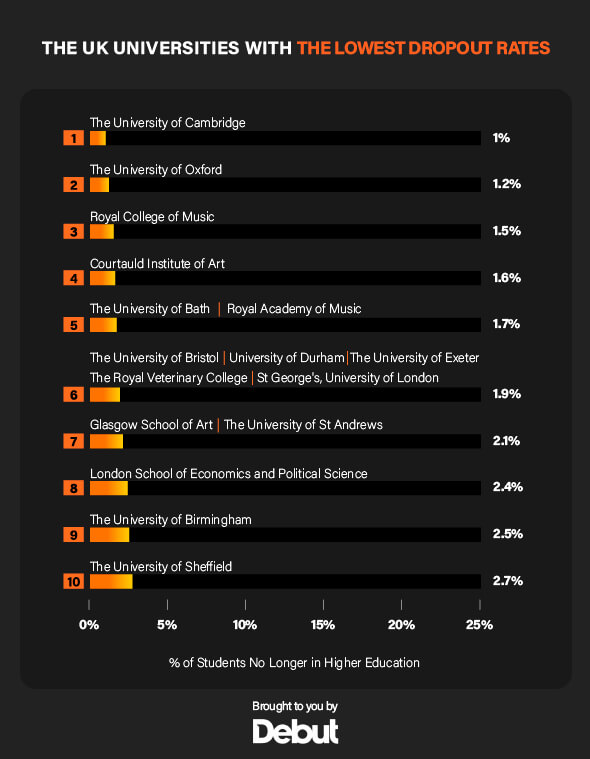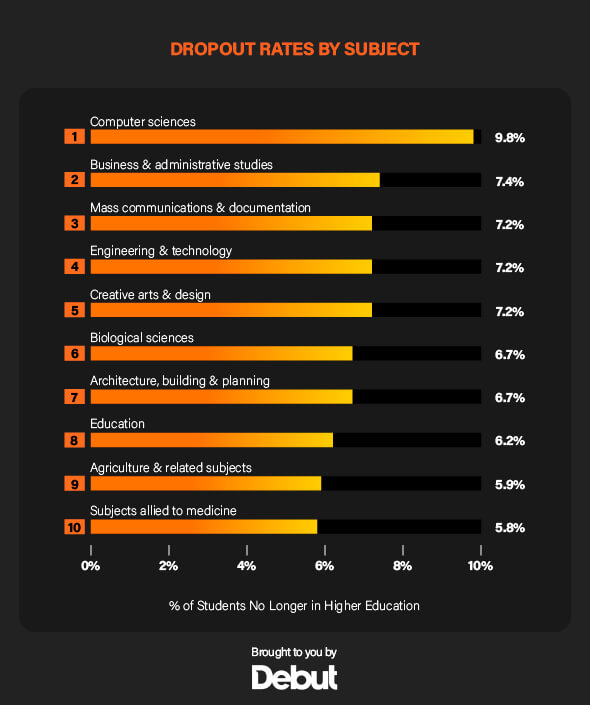
Table of Contents
Which universities have the highest & lowest dropout rates?
Earning a degree can be an excellent way of opening up doors to a wider range of career opportunities, with many jobs now making it a qualification a requirement for candidates. However, university isn’t for everyone, and for some, it may not turn out to be the right decision.
On average, 6 in every 100 (6.3%) students in the UK drop out of university.
But, which UK universities have the highest and lowest dropout rates? Our insights team studied the data from over 140 of the country’s higher education institutions to find out university dropout statistics.
The UK universities with the lowest dropout rates
Oxbridge sees the lowest dropout rates.
Our research shows that Oxbridge is the best at retaining students, with the University of Cambridge losing just 1% and the University of Oxford losing 1.2% as dropouts. As the two highest ranked universities in the country, it makes sense that students are less likely to leave their studies before graduating.
When looking at the top 10 universities with the lowest dropout rates, most can be found in the top 20 on the Complete University Guide’s league table, with just two that rank outside of this – St George’s, University of London (ranked 47), and the University of Sheffield (ranked 33).

Royale College of Music Dropout
With a dropout rate of only 1.5%, the Royale College of Music stands as a testament to its commitment to nurturing musical talent and academic excellence. Students here are not only immersed in a vibrant musical environment but also benefit from a supportive community and top-notch resources, ensuring that they stay engaged and motivated throughout their academic journey.
Courtauld Institute of Art Dropout
At the Courtauld Institute of Art, the dropout rate of just 1.6% reflects the institution’s dedication to fostering a stimulating and enriching learning experience in the realm of art history and conservation. Students are encouraged to explore their artistic passions while receiving personalized attention and guidance from renowned faculty members, helping them to succeed academically and professionally.
The University of Bath Dropout
With a dropout rate of only 1.7%, the University of Bath maintains its reputation for providing a supportive and inclusive learning environment across a range of disciplines. Renowned for its strong emphasis on research and innovation, Bath offers students the opportunity to excel both academically and personally, ensuring that they graduate with the skills and knowledge needed to thrive in their chosen fields.
The University of Bristol Dropout
The University of Bristol boasts a dropout rate of just 1.9%, reflecting its status as a leading institution for academic excellence and student satisfaction. With a diverse and vibrant campus community, Bristol offers students a wealth of opportunities for personal and intellectual growth, supported by world-class facilities and a dedicated faculty committed to their success.
Glasgow School of Art Dropout
With a dropout rate of only 2.1%, the Glasgow School of Art is renowned for its innovative approach to art and design education. Students here are encouraged to push the boundaries of their creativity while receiving personalized support and mentorship from industry professionals, ensuring that they develop the skills and confidence needed to succeed in the competitive world of art and design.
London School of Economics and Political Science Dropout
The London School of Economics and Political Science maintains a dropout rate of just 2.4%, underscoring its reputation as a global leader in social science education and research. With a focus on critical thinking and real-world application, LSE equips students with the knowledge and skills to address complex societal challenges, ensuring that they emerge as engaged and informed citizens ready to make a positive impact on the world.
The University of Birmingham Dropout
With a dropout rate of only 2.5%, the University of Birmingham is committed to providing a supportive and inclusive learning environment where students can thrive academically and personally. Renowned for its research-led teaching and strong sense of community, Birmingham offers students a wealth of opportunities for intellectual exploration and personal development, ensuring that they graduate as confident and capable individuals ready to make their mark on the world.
The University of Sheffield Dropout
The University of Sheffield maintains a dropout rate of just 2.7%, reflecting its commitment to providing a transformative learning experience that empowers students to reach their full potential. With a focus on interdisciplinary collaboration and real-world impact, Sheffield prepares students to tackle the challenges of tomorrow with confidence and innovation, ensuring that they emerge as leaders in their chosen fields.
The UK universities with the highest dropout rates
1 in 5 students drop out from London Metropolitan University; the highest in the UK
We’ve found that the university with the highest dropout rate is London Metropolitan University; an institution which loses a staggering 18.6% of its students, a total of 180 out of 980 students who enrolled to study.
Reflecting the likes of Oxford and Cambridge, London Metropolitan University sits near the bottom of the league table at 126, just five places above the lowest-ranked institution.
Middlesex University is the only institution in the bottom 10 that ranks in the league table’s top 100, seeing a dropout percentage of 12.6% but a ranking of 89.

The 10 year differences in dropout rates
Across the UK dropout rates have decreased by 1.1% since 2008
Between the 2007/08 academic year and 2017/18, some universities have seen huge differences, with a number of institutions decreasing their dropout rate, while others have seen it increase.
While the University of the Highlands and Islands has seen its dropout rate decrease by 19.1%, the University of Abertay Dundee has actually seen this increase by 7%.
The combined figures across all universities, however, have shown a decrease over the last decade, with a dropout rate of 7.3% in the 2007/08 academic year, compared to 6.2% in 2017/18; a decline of 1.1%.
Dropout rates by subject
Students studying Computer Science are most likely to drop out of from their degree studies
While we can see that some universities have higher dropout rates than others, the same is true for the subjects which students study. So what major has the highest dropout rate?
Our insights reveal that computer sciences is the subject which suffers from the highest dropout rate at 9.8%, with medicine, dentistry and veterinary science being the subject which sees the lowest at just 1.5%.

When we look at the difference between 2007/08 and 2017/18, we see that every subject has seen a reduced dropout rate, although some have seen a far more dramatic decrease than others.
Combined subjects have reduced their dropout rate by 23.8%, while physical sciences has dropped by 12.7%.
Medicine, dentistry and veterinary science saw the smallest drop of 1.4%, followed by education which had a reduction of 3.4%.
While there are some universities that have actually increased their dropout rate, it seems that, overall, more students than ever are completing their studies in some capacity, with the top institutions in the country hanging onto their students most consistently.
If you drop out of your university course; what does this mean future employment opportunities?
Usmaan Qureshi, Client Success Manager from Debut advises:
“Leaving an undergraduate course before completion does rule out some opportunities, but opens up many others.
When we speak with candidates, they are often really surprised at the companies with opportunities that are still available to them for Higher / Degree apprenticeships and graduate schemes.
The apprenticeship levy has changed the landscape. Not only is there a much bigger incentive for employers to bring on apprenticeships, but the data suggests they are often much better value. Retention rates are roughly double that for graduates and often the employee can contribute positively much earlier on.
Holly Stocker, Senior Partnership Manager from Debut continued:
Companies that are at the forefront of this revolution and a number of companies have a significant number of vacancies in these areas including large employers like Capgemini and EY.”
Methodology
Using data from the Higher Education Statistics Agency, we were able to discover the rate at which students were dropping out of higher education in the period of 2007/08 and 2017/18. This data looked at students dropping out in these years that had entered full-time higher education in the previous year.
We used the university league tables from the Complete University Guide to get the rankings for each institution.


